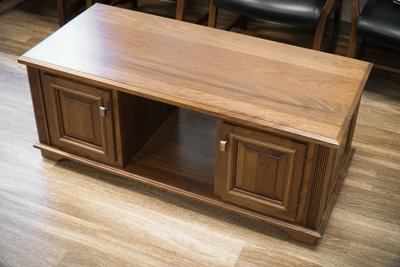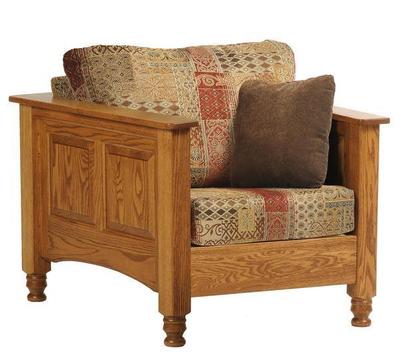
What You Need to Know About Walnut Wood
Solid wood furniture made with walnut wood is meant to impress and it never falls short of the mark. In the world of custom furniture, walnut wood is a dream as it is easy to work with and finishes beautifully.
Want to know more about walnut wood? Let’s take a look at what makes it a luxury.
Walnut wood is revered for its rich, dark color. There are many varieties of walnut trees, but just a few are native to North America. It’s the Eastern Black Walnut (also called the American Black Walnut or American Walnut) that is most often used for woodworking. Beautiful walnut trees found in the midwest hail from Ohio, Illinois, and Indiana. Walnut trees can grow to be 100 feet tall or more with a diameter of 30 to 40 inches, which provides a consistent grain that makes it wonderful to work with.


Characteristics and Qualities of Walnut Wood
- Stable and hard
- Strong and durable, yet not heavy
- Dense with good shock resistance
- Easy to work with for turning and carving
- Nails and glues well
- Exhibits good bending qualities
- Finishes well
- A fine, fairly straight grain
- Resistant to decay
- Displays unique colors
- Unique grain characteristics make it popular

The Colors of Walnut Wood
The colors found in walnut wood vary depending on what part of the tree the wood is from. The sapwood of the tree is the outermost part of the tree. In a walnut tree, the sapwood colors include pale yellow and gray to almost a rich white. The heartwood of the tree is the innermost part of the tree. In a walnut tree, the heartwood gets down to the nitty gritty with rich colors that include a range of dark browns and light browns with some purplish hues, grays, reddish rays, and dark streaks included.

The Grain Pattern of Walnut Wood
Walnut wood features a fine, straight grain that’s a bit coarse in texture and occasionally features knots or some irregularities possibly including some waves or curls. A “crotch grain” can happen naturally where the tree forks (divides into two branches) causing the wood fibers to wrinkle. Every year a new annual ring tries to fit in the space left and the wrinkles continue to form where the wood is being compressed. A burl is caused by growths on the tree that resemble warts, if you will. Burls are caused by abnormal division of growth cells, providing a way for the tree to grow new limbs if it needs to. A burl in the grain of walnut wood looks like a tight swirly pattern. Walnut is unique with a grain pattern that’s in between prominent oak and the uniform texture of maple.
Comparing Walnut Wood to Oak Wood
The Wood Grain
Oak wood has a prominent grain pattern. It has a distinct look with its wavy grain. Walnut has a straighter grain.


The Color
Oak is a light colored wood providing a range of light to medium brown tones. Walnut is a darker wood with shades that range from pale browns to dark browns.


The Durability
Both oak and walnut are strong, supportive woods.
The Price
Walnut wood is considered a premium wood and is more expensive than other hardwoods. Walnut lumber is usually not available in long lengths and usually has more knots and sap wood than other woods, requiring the purchase of more lumber to make furniture, making it more costly.
Is Walnut a Good Wood for Furniture?
- Often used for formal furniture and executive office furniture
- Often finished in a dark or natural stain to complement its dark shades
- It’s a hard wood and valued for its strength, grain and color
- Offers a very smooth finish
Secrets About Walnut Wood
Have you heard that cherry wood will darken over time? As walnut wood ages, it can get lighter! A rich honey color can come through. The change in color is not as pronounced as the patina that develops in cherry wood. Walnut wood is an excellent candidate for musical instruments and is used in guitars and violins. It is an excellent candidate for steam bending as well.
Chat With Us About Walnut Wood
Do you have any furniture made of walnut wood? What do you like or dislike about it? Would you pay extra for furniture made with walnut wood? Please let us know in the comments below!





I have some walnut lumber that was supposedly milled in 1918. I planed it and it is reddish in color like a cherry. I am told it is antique black walnut but the color does not match any of the black walnut I have in my shop. Is it possible for old walnut to look more like cherry ?
I can send a picture if needed
Hello Kerry,
Besides using reclaimed lumber that is usually pine or oak, our woodworkers do not build with antique lumber so we don’t have specific experience with that.
The heartwood of the walnut tree can include shades of light brown, purple, gray and reddish tints. Over the years, walnut wood develops a lovely patina and while we can’t say for sure, it’s possible your lumber is from walnut heartwood that contained more red hues than others.
Thank you for your question and for visiting us on Timber to Table.
Is walnut is greater than teak compared to its quality ,durability,asthetics and overall look after natural polish?
Hello Akhilesh,
We don’t sell much furniture made of teak wood, but here’s how some teak characteristics compare to walnut.
Teak features honey colored brown tones and walnut features darker brown tones.
Both strong woods, teak is a little harder on the Janka Hardness Scale with a hardness rating of 1155 to walnut wood’s rating of 1010.
Teak is resistant to natural expansion and contraction with exposure to humidity, but it’s harder to find teak wood that’s sustainably harvested.
Walnut wood offers a luxurious look. It’s a versatile choice that won’t warp, naturally resists decay and is easy to carve into intricate designs.
I hope this helps and thank you for visiting us on Timber to Table.
Hi Beth, I live in the Pacific North West (N. CA). I am working on a live-edge walnut slab for a custom coffee table and I am having a little trouble finding anyone who has ever tried combining Pacific Madrone and walnut in a live-edge table project before. The reason why is because I have a couple really cook looking spalted Madrone live-edge slabs that are not very large. But they look to be perfect for making some live-edge slab style legs for a coffee table aside from a little checking and splits. But my question is do you have any experience combining the two species on any furniture projects? And if so, how well do the two contrast?
Hello Jonathan,
Sounds like a wonderful project you are working on. I’m sorry, but our Amish woodworkers do not work with Pacific Madrone wood. We are not familiar with how those slabs would combine or contrast. Best of luck with your project.
Thank you for your question and for visiting us on Timber to Table.